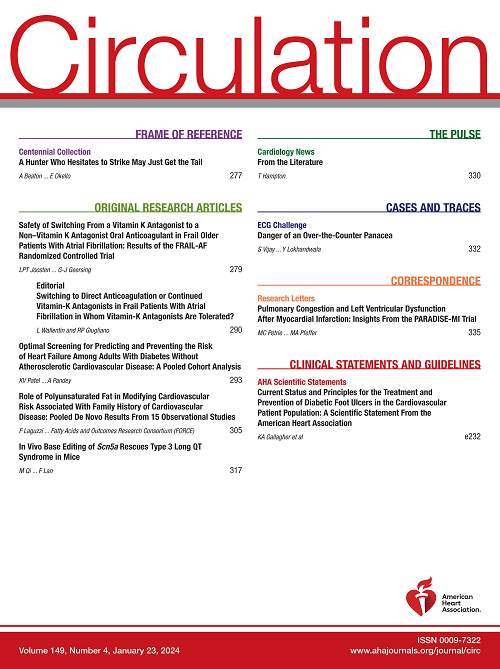Targeting Fibrinolytic Inhibition for Venous Thromboembolism Treatment: Overview of an Emerging Therapeutic Approach.
IF 35.5
1区 医学
Q1 CARDIAC & CARDIOVASCULAR SYSTEMS
引用次数: 0
Abstract
Venous thrombosis and pulmonary embolism (venous thromboembolism) are important causes of morbidity and mortality worldwide. In patients with venous thromboembolism, thrombi obstruct blood vessels and resist physiological dissolution (fibrinolysis), which can be life threatening and cause chronic complications. Plasminogen activator therapy, which was developed >50 years ago, is effective in dissolving thrombi but has unacceptable bleeding risks. Safe dissolution of thrombi in patients with venous thromboembolism has been elusive despite multiple innovations in plasminogen activator design and catheter-based therapy. Evidence now suggests that fibrinolysis is rigidly controlled by endogenous fibrinolysis inhibitors, including α2-antiplasmin, plasminogen activator inhibitor-1, and thrombin-activable fibrinolysis inhibitor. Elevated levels of these fibrinolysis inhibitors are associated with an increased risk of venous thromboembolism in humans. New therapeutic paradigms suggest that accelerated and effective fibrinolysis may be achieved safely by therapeutically targeting these fibrinolytic inhibitors in venous thromboembolism. In this article, we discuss the role of fibrinolytic components in venous thromboembolism and the current status of research and development targeting fibrinolysis inhibitors.针对纤溶抑制治疗静脉血栓栓塞症:新兴治疗方法概述。
静脉血栓和肺栓塞(静脉血栓栓塞症)是全球发病率和死亡率的重要原因。在静脉血栓栓塞症患者中,血栓阻塞血管并抗拒生理性溶解(纤维蛋白溶解),可能威胁生命并导致慢性并发症。50 多年前开发的血浆酶原激活剂疗法能有效溶解血栓,但有不可接受的出血风险。尽管在纤溶酶原激活剂的设计和导管疗法方面进行了多次创新,但静脉血栓栓塞症患者血栓的安全溶解一直难以实现。目前有证据表明,纤溶受到内源性纤溶抑制剂的严格控制,包括α2-抗蛋白酶、纤溶酶原激活剂抑制剂-1和凝血酶激活型纤溶抑制剂。这些纤溶抑制剂水平的升高与人体静脉血栓栓塞风险的增加有关。新的治疗范例表明,在静脉血栓栓塞治疗中,以这些纤溶抑制剂为治疗靶点,可以安全地实现加速和有效的纤溶。在本文中,我们将讨论纤溶成分在静脉血栓栓塞症中的作用以及针对纤溶抑制剂的研发现状。
本文章由计算机程序翻译,如有差异,请以英文原文为准。
求助全文
约1分钟内获得全文
求助全文
来源期刊

Circulation
医学-外周血管病
CiteScore
45.70
自引率
2.10%
发文量
1473
审稿时长
2 months
期刊介绍:
Circulation is a platform that publishes a diverse range of content related to cardiovascular health and disease. This includes original research manuscripts, review articles, and other contributions spanning observational studies, clinical trials, epidemiology, health services, outcomes studies, and advancements in basic and translational research. The journal serves as a vital resource for professionals and researchers in the field of cardiovascular health, providing a comprehensive platform for disseminating knowledge and fostering advancements in the understanding and management of cardiovascular issues.
 求助内容:
求助内容: 应助结果提醒方式:
应助结果提醒方式:


